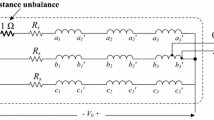Abstract
Early detection and diagnosis of faults in synchronous machine (SM) are crucial since they drive critical applications. In this paper, the authors exploited the combined information from numerical simulation and experimental validation to evaluate the merits of certain fault indicators, for detecting machine faults. A specially designed SM was chosen for both simulation and measurement with the ability to physically introduce electro-mechanical failures. Shorted turn fault was made through accessible intermediate terminals of respective stator and rotor windings. Eccentricity faults of different intensity were created by suitable changeover of customized end-shield. Finite element method was used to develop healthy and faulty simulation models. The experimental setup facilitated measurement and subsequent calculation of key parameters such as stator branch currents, phase current, circulating current, rotor field current and shaft voltage. From the investigation of both simulation and experimental data, field current and shaft voltage were found to be two effective fault indicators from safety and reliability prospects. Both indicators have the ability to identify and discriminate between electro-mechanical and electrical faults. Further, it is demonstrated that with availability of physical dimensions and measured rotor parameters, a know-how can be created to detect failures, well before a catastrophic event occurs.















Similar content being viewed by others
References
Seinsch HO (2001) Monitoring und diagnose elektrischer maschinenund Antriebe. Stand der Forschung, Entwicklu ngstendenzen, Frankfurt, VDE-Haus (in German)
Tavner PJ (2008) Review of condition monitoring of rotating electrical machines. Inst Eng Tech Electr Power Appl 2(4):215–247
Toliyat HA, Nandi S, Choi S, Kelk HM (2012) Electric machines: modeling, condition monitoring, and fault diagnosis. CRC Press, Boca Raton, p 272
Sahoo SK, Rodriguez P, Sulowicz M (2014) Comparative investigation of fault indicators for synchronous machine failures. International conference on electrical machines (ICEM), Berlin, 2–5 Sept
Abdallah AA, Refnier J, Faucher J, Dagues B (2005) Simulation of internal faults in permanent magnet synchronous machines. Int Conf power Electr Drive Syst 2:1390–1395
Hongzhong M, Yuanyuan D, Ju P, Limin Z (2008) The application of ANN in fault diagnosis for generator rotor winding turn-to-turn faults. In: IEEE power and energy society general meeting-conversion of electric energy in the 21st Centrury
Al-Nuaim NA, Toliyat HA (1998) A novel method for dynamic simulation and detection of dynamic air gap eccentricity in synchronous machines. IEEE Trans Energy Convers 13(2):156–162
Pöyhönen S, Negrea M, Jover P, Arkkio A, Hyötyniemi H (2003) Numerical magnetic field analysis and signal processing for fault diagnostics of electrical machines. Int J Comput Math Electr Electr Eng 4:969–981
Neti P, Nandi S (2006) Stator inter-turn fault detection ofsynchronous machines using field current signature analysis. IEEE Ind App Conf Tampa, FL, Oct
Dorrell DG, Thomson WT, Roach S (1997) Analysis of airgap flux, current, and vibration signals as a function of a combination of static and dynamic eccentricity in 3-phase induction motors. IEEE Trans Ind Appl 33:24–34
Bruzzese C, Joksimovic G (2011) Harmonic signatures of static eccentricities in the stator voltages and in the rotor current of no-load salient pole synchronous generators. IEEE Trans Ind Electron 58(5):1606–1624
Rodriguez P, Rzeszucinski P, Sulowicz M, Disselnkoetter R, Ahrend U, Pinto CT, Ottewill JR, Wildermuth S (2013) Stator circulating currents as media of fault detection in synchronous motors, SDEMPED, 27–30 Aug
Picot A, Obeid Z, Régnier J, Poignant S, Darnis O, Maussion P (2014) Statistic-based spectral indicator for bearing fault detection in permanent-magnet synchronous machines using the stator current. Mech Syst Signal Process 46(2):424–441
Chakraborty S, Keller E, Ray A, Mayer J (2013) Detection and estimation of demagnetization faults in permanent magnet synchronous motors. Electr Power Syst Res 96:225–236
Fjałkowski Z, Nouri H (2015) Phase shift of the current under a single-phase short-circuit in the stator winding of a turbogenerator with double winding per phase. Arch für Elektrotech 97(3):251–259
Urresty J-C, Riba J-R, Romeral L, Ortega JA (2015) Mixed resistive unbalance and winding inter-turn faults model of permanent magnet synchronous motors. Electr Eng 97(1):75–85
Vaseghi B, Takorabet N, Nahid-Mobarakeh B, Tabar FM (2011) Modelling and study of PM machines with inter-turn fault dyamic model-FEM model. Electr Power Syst Res (EPSR) 81(8):1715–1722
Geramifard O, Xu J-X, Panda SK (2013) Fault detection and diagnosis in synchronous motors using hidden Markov model-based semi-nonparametric approach. Eng Appl Artif Intell 26(8):1919–1929
Götkas T, Arkan M, Özguven ÖF (2015) Detection of rotor fault in three-phase induction motor in case of low-frequency load oscillation. Arch für Elektrotech 97(4):337–345
Ilamparithi T, Nandi S, Subramanian J (2015) A disassembly-free offline detection and condition monitoring technique for eccentricity faults in salient-pole synchronous machines. IEEE Trans Ind Appl 51(2):1505–1515
Ebrahimi BM, Roshtkhari MJ, Faiz J, Khatami SV (2014) Advanced eccentricity fault recognition in permanent magnet synchronous motors using stator current signature analysis. IEEE Trans Ind Electron 61(4):2041–2052
Rodriguez P (2007) Current-, Force- and Vibration-Based Techniques for Induction Motor Condition Monitoring, Ph.D. Thesis, Helsinki University of Technology, May, pp 1–181
Arkkio A (1987) Analysis of induction motors based on the numerical solutions of the magnetic field and circuit equations, Helsinki. Acta polytechnica scandinivia, electrical engineering series, No. 59, ISBN 951-666-250-1, pp 97
Rodriguez P, Belahcen A, Arkkio A, Laiho A, A-Daviu JA (2008) Air-gap force distribution and vibration pattern of induction motors under dynamic eccentricity. Arch für Elektrotech 90(3):209–218
Ferreira JG, Sobczyk T, Warzecha A (2015) Multi-criteria diagnosis of synchronous machines using Welch method. Tech Tran Electr Eng 1–E:343–352
Author information
Authors and Affiliations
Corresponding author
Rights and permissions
About this article
Cite this article
Sahoo, S., Rodriguez, P. & Sulowicz, M. Evaluation of different monitoring parameters for synchronous machine fault diagnostics. Electr Eng 99, 551–560 (2017). https://doi.org/10.1007/s00202-016-0381-6
Received:
Accepted:
Published:
Issue Date:
DOI: https://doi.org/10.1007/s00202-016-0381-6




